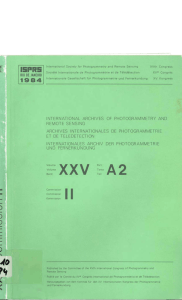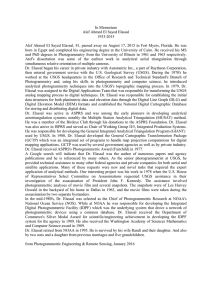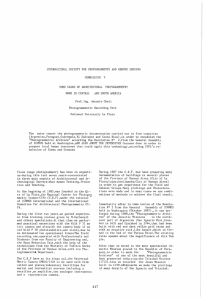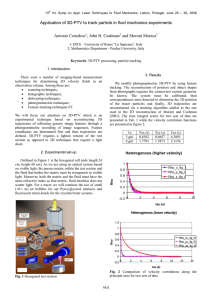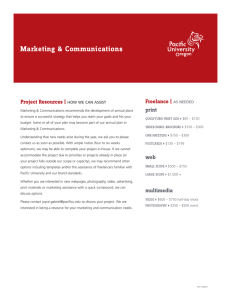COMPREHENSIVE STUDY APPLICATION OF PHOTOGRAMMETRY
advertisement
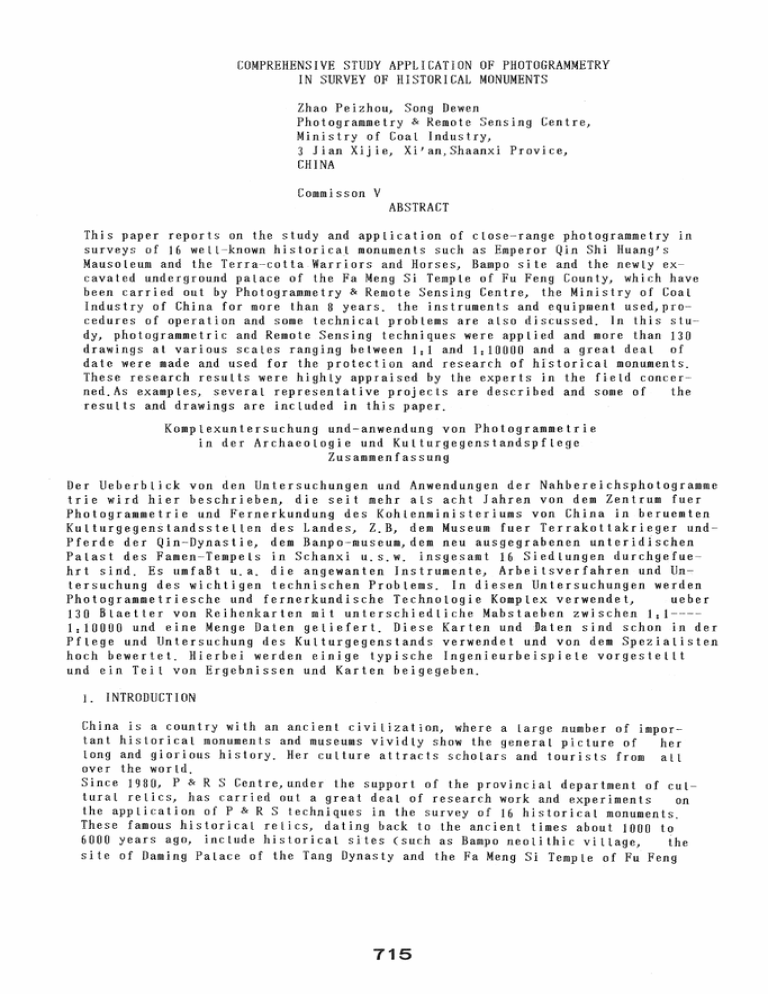
COMPREHENSIVE STUDY APPLICATION OF PHOTOGRAMMETRY IN SURVEY OF HISTORICAL MONUMENTS Zhao Peizhou, Song Dewen Photogrammetry & Remote Sensing Centre, Ministry of Coal Industry, 3 1 ian Xij ie, Xi' an, Shaanxi Provice, CHINA Commisson V ABSTRACT This paper reports on the study and application of close-range photogrammetry in surveys of 16 well-known historical monuments such as Emperor Qin Shi Huang's Mausoleum and the Terra-cotta Warriors and Horses, Bampo site and the newly ex-cavated underground paLace of the Fa Meng Si Temple of Fu Feng County, which have been carried out by Photogrammetry & Remote Sensing Centre, the Ministry of Coal Industry of China for more than 8 years. the instruments and equipment used,procedures of operation and some technical problems are also discussed. In this study, photogrammetric and Remote Sensing techniques were applied and more than 130 drawings at various scales ranging between 1:1 and 1:10000 and a great deal of date were made and used for the protection and research of historical monuments. These research results were highly appraised by the experts in the field concerned.As examples, several representative projects are described and some of the results and drawings are included in this paper. Komplexuntersuchung und-anwendung von Photogrammetrie in der ArchaeoLogie und Kulturgegenstandspflege Zusammenfassung Der Ueberblick von den Untersuchungen und Anwendungen der Nahbereichsphotogramme trie wird hier beschrieben, die seit mehr als acht lahren von dem Zentrum fuer Photogrammetrie und Fernerkundunt des Kohlenministeriums von China in beruemten KuLturgegenstandsstellen des Landes, Z.B, dem Museum fuer Terrakottakrieger undPferde der Qin-Dynastie, dem Banpo-museum,dem neu ausgegrabenen unteridischen Palast des Famen-TempeLs in Schanxi u.s.w. insgesamt 16 Siedlungen durchgefuehrt sind. Es umfaBt u. a. die angewanten Instrumente, Arbei tsverfahren und llntersuchung des wichtigen technischen Problems. In diesen Untersuchungen werden Photogrammetriesche und fernerkundische Technologie Komplex verwendet, ueber 130 Blaetler von Reihenkarten mit unterschiedliche Mabstaeben zwischen 1:1---1:10000 und eine Menge Daten geLiefert. Diese Karten und Daten sind schon in der Pflege und Untersuchung des KUlturgegenstands verwendet und von dem Spezialisten hoch bewertet. Hierbei werden einige typische Ingenieurbeispiete vorgestellt und ein Teil von Ergebnissen und Karten beigegeben. 1. INTRODUCTION China is a country with an ancient civiLization, where a Large number of important historicaL monuments and museums vividly show the general picture of her long and giorious history. Her culture attracts scholars and tourists from all over the worLd. Sin c e 1980, P & R S Cen t r e} un d e r the sup p 0 r t 0 f the pro v inc i a Ide par t men t 0 feu I tural relics, has carried out a great deal of research work and experiments on the application of P & R S techniques in the survey of 16 historicaL monuments. These famous historical relics, dating back to the ancient times about 1000 to 6000 years ago, include historical sites (such as Bampo neolithic village, the site of Daming Palace of the Tang Dynasty and the Fa Meng SI Temple of Fu Feng 715 County), architectural heritage(such as the Bell Tower, the City WaLL of Xi/an and ancient pagodas), grottoes (Great Buddha Temple of Bin Xian County), stone carvings (those of Shungling and Zhao Ling Mousoleums), frescoes and bombs(Emperor Qin Shi Huang's Mausoleum and the Terra-cotta Warriors & Horses Pits). More than 130 drawings at various scales ranging between 1:1 and 1:10000 have been made by using Low-altitude photography and cLose-range photogrammetric and remote sensing techniques. Numerous data have provided a reliable reference for the protection of historical monum~nts) maintenance of architectural heritage,archaeologic res~arch and the development of tourism. Research results were highly appraised by the experts in the field concerned and won the Scientific and Technological Progress Prize of Shaanxi Province in 1987. 2. ACCURACY TEST AND ACTUAL ACCURACY 2.1. I nd 0 0 r Con t r 0 Fie Ld A number of control points,with clear marks,were laid out in the system according to certain requiremenh, and their spatiaL coordinates were determined. the system had a steel frame structure,with the dimensions 3.9m x 1.0m x 2.8m, containing 50 black-and-white circular targets welL distributed in three planes on the frame and the wall. The control field was established with traditional intersection and two kinds ,of algorithms were used, one of which was computed using resection and intersection, whi Le the other was jlhotogrammtric measurement wi th pseudoscopi c image of theodoli teo In our study, The MSE of coordinate was ± O.103mm, and the relative accuracy was about 1/50000 to 1/60000,'which were determined wi th 50 control polnts In diffetent observation directions. 2.2, Accuracy Test In order to study the accuracy of close-range stereo photogrammetric operation to make comparisons between differeht computatIon methods, simulation and operation tests were carried out with Jenoptic Jena UMK 10/1318, 19/1318 and OPTON SMK-120. the tests were carried out in the indoor field where the distance Y was 6m. In thetests, normal and convergent steropairs were photographed and then they were processed by applying such analytical procedures as colfinearity, cop[aharity and Direct Linear Transformation( DLT ). The following results have b~en obtained by comparison: 1) Positional accuracy depended upon the measuring instrument, or we couLd say, measurement error was one of the main sources which has an effect on positionaL accuracy_ 2) Accuracy of horizontal photography was better than of oblique photography. 3) No remarkable difference has been found between di-fferent algori thms in computing the accuracy of points to be determined. Comparatively speaking,DLT approach was slightly better than the others. 4) In order to improve the accuracy of points to be determined, it is advisable to use multistation photography, to take compensation of systematic error into account and to adopt bundle adjustment. ~nd 2.3. Actual Accuracy So far as ordinary objects were concerned~ the optimum accuracy in analog approach was about Y/2000 to Y/4000 and the relative accuracy of a point in highprecision analytical approach was Y/5000 to Y/45000. 3. SOME TECHNICAL ASPECTS IN PHOTOGRAMMETRIC SURVEY OF HISTORICAL MONUMENTS 3.1. Controls and Relative Controls 716 In close--range photogrammetric surveys, there frequently exists certain circumstances that may permit or require reLative controls. The versatility of the means the of controls may sometimes play an obvious role in simpLifying and reducing control surveys. Whi te mapping thematic maps of historical monuments, ei ther tradition control surveyor the survey, of separating hori ontal from verticaL can be used. In the latter, the scale can be reduced according to horizontal dis tance and elevation can be determined with beLow-order Levelling, so that the levelling of a model can be achieved. As an example, the combination of controls and relative controls was used in surveying the Great Buddha Tempt because of the short object-distan e(onty 4m) and the higher Buddhist tatue(about 20m). From the top of the Buddhist statue were suspended several plumblines to which ~rgets were fixed. Forward inter ection and resection were carried out to the bottom of the statue and the coordinates of points at the top of it were determined from the plumb lines. During the survey of stone sculptures "The Si Zhaoling Steeds", relative control were set up respectively for horizontal and vertical, and contours were directly mapped by means of wedge--shaped rule 3.2. Photography photographic procedure includes locating camera stations, seLecting photographic material, filters and il(~mination devices. Either singLecamera or stereoscopic photography can be used to Qbtain stereopairs. To increase the accuracy of measurements and facilitate the identification of control points, arlificiL targe ts may generaLly be required. FiLters are particularly important in the photography of frescoes. Whi Ie taking infrared photography, the use of filters of different wavelengths combined with corresponding photographic materials will facilitate the spectral separation in multispectral photography. 3. 3. S e 1e c t i on 0 f Pro j e c t i on Plan e Selection of projection plane is necessary for gr ic presentation ofobjects in the best w~y and optimum accuracy. If a plane type or nearplane object is being photographed, such as frescoes and facade of a building, the photographic base line should be parallel with the plane surface as fat as possible. As for the irregular objects such as stone carvings and terra-cotta figures, the selected projection plane shouLd be targeted in-situ. For those ¥ihich can be expanded, such as arched frescoes, they can be partially photographed and mapped according to error requirements, or the arched shape can be formulated and then corrcted point by point. 3.4. Stereoplotting The special characteristics of close-range photos that the image may sometimes concentrate onto a centain part and depth of field too deep would resuld in a number of difficulties in the procedure of image orienyatiori. Therefore, it may be nece~sary to make the following remarks: 1) Accuracy of centering the photo in the registering fram-e shOUld increase with the depth of field. 2) The procedure of orientation can be speeded up if relative orientation and levelling of model are carried out simultaneously. 3) Analytic plotters which have the advantages of both analog and analytic approach~ are particularly suitable for processing cLose-range photos. 4. EXAMPLES OF APPLICATION 1 ILLUSIJ.:HATf ION photogrammetric survey of Xi'an Bell site.. Right: the east elevation :50 . li'ig .. 2 C sculptures "the Six Zhao: 1: 4. e 1 4.1. Photogrammetric Survey of Archi tectural Heri tage SMK-120 and UMK 10/1318 were used to acquire otography. Accuracy of control points was ±lcm and the photo scale was 1:500 to 1:600, whi le the map scaLe was 1: 50. ELevation drawings and pLans of Xi/an BeLt Tower were made with Stereometro graph F and graphic accuracy of 5cm was achieved (Fig. I), Then ortho plans at a scaLe of 1:50 were produced from ae lal photo of 1 4000 scale. Densification of some characteristic point by u ing opLanarity approach and DLT resulted in an accuracy of 2cm. 4.2. Rapid Mapping of Histirical Si tes The archaeoLogical excavation of the Fa Meng Si TempLe of Fu Feng County in Shaanxi Province is the most important disco~ery for the archaeoLogical study of the Tang Dynasty and Buddhism. Plans and ortho pLans of its underground palace were mapped from the photography taken with SMK-120&Mamiya RB-67. Meanwhile, contour drawings for the extremely rare Tang Dynasty goLd and jade articLes, which are extremely valuable for research . have been made. In the site of Daming Palace of the Tang Dynasty, low-aLtitude pfotography by virtue of captive balloon was used for making plans and ortho pLans of the site. 4.3. Stone Carvings and Frescoes While carrying out photogrammetric surveys of the famous stone scuLptures of the Six Zhaoling Steeds, an SMK-120 with close-up Lens was used to take photos at a distance of 1. 5 meters from the stone sculptures. The Photo scale was 1: 25. Drawings were mapped in WILD BC-2 analytical pLotter with the help of relative controls. The Map scale was 1:4 and the contour interval was 2.5mm(Fig.2),(Fig31 Metric and non-metric cameras were used for taking photography of frescoes (fig.4), which would behandled in office work with large rectifiers and plotters or processed in computer assisted image processing systems. Fig. 3. Contour dravling of Shungling Stone Carvines of the Tang Dynasty.. 1eft: male lion.. Right: female on.. Scale of the drawing: 1:10 .. 1 }'ig .. 4.. Frescoes at Yao \1ang I'lountain of' Yao Xian County. Left: photo of the site.. Eight: line drawing. Scale of the drawing: 1:15. Fig" 5. Grottoes in the Great Buddha Temple of' Bin Xian County Left: photo of the whole 13uddhist statue taken with fish-eye lens, at the lower right corner stand two surveyors . The Buddhist statu.e is 20 metre high. Right: contour drawing of t.h,e statue. Scale of the drawing: 1:50. 4.4. Survey of Grot toes An example is the survey of the Great Buddh TempLe of Bin xi Province. Whi Le photographing the i te, sa ies of me cause blind spots and "ITO" phenomenon frequently occured ject-distance(only 4m), the hi r Buddhist tatue and the Xi an Coun ty) in Shaanures were adopted bedue to the short obdeep depth af field. (FJg.5). Selecting and ctty d t rmining the reference projection pLane. Using intersection in ucti w th rel tive controls. c los e - ups h 0Applying non-metri and adopting part L otogr enomanon. to 5educe blind spot otto Suitably allocating and 1t t i on in 5) Selecting appropr t tm. 6) Paying more attention appe rance f the Bud ist t tu and provldin~J technological design fo colour prin ing. 1) 2) 3) ts 4) 4.5. Survey of Bampo Si t Vertical aerial photogr taken rom super-low amer ttitude was used for carrying out photogrammetric surv y of the exc t on site in Bampo Museum Hatt. In the proj ect , 20 drawing 0 c 1 tu roduced at a scale of 1: 25 and the contour interv 0 2cm by u ogether with stereopLotters. Meanwhi le, photogrammetri experiments wer made. And then 2 maps of Bampo i te t 1 30 c Le wer reduction compi [ation from original drawing 1 scat (F tim the experiment on densification of UntroL po nt wa rrie out analytical aeriaL triangulation, -in which the hori on at cc r y of ± 1. Scm and verU cal accuracy of ± 2.0cm were ach eved. Fig .. 6 .. up on the a Left: operating site. 3cale of the drawing: set e. Fig .. 7. -" t lluang s close (98. photo of l\Iuseu.IYl of Emperor Qin 3hi Warriors and horses. Lower: taking ography in t .1 .. :l~·\llermal-I:J~. imagery ~;iausoleum, the Huang I s mos:8-ic of t.rle a~rea of .J~mperor Qin centre of which is the l<ausoleurn. 4.6. Application of Remote Sensing in Detection of Archaeological Sites & Tombs Our centre has completed remote sensing flights over the area of Emperor Qin Shi Hu an g 's Mau soL e um, wh i c h c 0 v e r s 60s qua r e k i L0 met res. BLac k - and - whit e p hot 0 g r a --phy, colour infrared photography and thermal infrared scanning have been carried out, as_lwell as.. close-orange photogrammetric surveys of various kinds of terra-cotta warriors and horses(Fig.7). Thematic maps of the Museum of Terra-cotta Warriors and Horses of the Qin Dynasty and contour drawings of representative clay warriors, horses and weapons have been made on the basis of those photographic data. Meanwhile, the sites of the inner and outer boundaries of the Mausoleum and the location of Terra-cotta Warriors and Horses Pits No.2 and No.3 have been ditermined by photo interpretation. Through interpretation of infrared and thermal infrared imagery(Fig.8) in identifying a group of archaeological sites, 28 among 33 sites have been proved to be in conformity with actual conditions. Furthermore, the southern boundary of Hua Qin Palace of the Tang Dynasty, which had been bu~ied for more than 1000 years, was discovered and the range of the active flowing slope within the scenic spot was determined. Another example in the successful application of remote sensing techniques is identifying the location of the biggest mausoleum for Emperors in ancient CHINA ----Zhaoling Mausole~m with 167 attendant tombs, whichhas achieved better result s. REFERENCES 1. WANG Zhizhuo, Photogrammetric Principle, Oct. 1979 2. feng Wenhao, Non-Topographic Photogrammetry, Nov. 1985 3. Song Dewen, Zhao Peizhou, Close-Range Photogrammetric Engineering in the De-- partment of Historical ReliEs and Archaeology, BuLletin of Surveying and Mapping No.6 1986 4. Zhao Peizhou, Shen Yaocheng, Photogrammetric Survey of Xi'an Bell Tower, Engineering Reconnaissance, No.3 1985 5. Song Dewen, Zhao Peizhou, Experiments on Balloon Photogrammetric Survey,Newsletter of Science and Technology in Surveying and Mapping, No.2 1984 6. Zhao Peizhou, Song Dewen, Shen Yaocheng, Mapping of the Historical Sits of Bampo Museum in Xi'an, Bulletin of Surveying and Mapping. No.5 1987 Zhao Peizhou, Shen Yaocheng, Rapid Mapping at a Extra Large Scale, Archaeology and Historical Relics, No.6 1982 7. 8. Yang Wengang, Application of Remote Sensing Technique in Archaeological Survey of Ling Tong County, Jan. 1987 723
